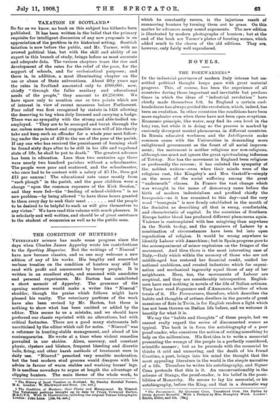THE CONDITION OF HUNTERS.-t
VETERINARY science has made some progress since the days when Charles James Apperley wrote his contributions to the Sporting Magazine. But the writings of "Nimrod" have now become classics, and AO one may welcome a new edition of any of his works. His lengthy and somewhat verbose treatise on the condition of hunters may still be read with profit and amusement by horsy people. It is written in an excellent style, and seasoned with anecdotes -and personal experiences. Mr. Barton has contributed s short memoir of Apperley. The grammar of the opening sentence would make a writer like "Nimrod" shudder, though the praise which follows might have pleased his vanity. The veterinary portions of the work have also been revised by Mr. Barton, but there is nothing to show what has been omitted or added by the editor. This seems to us a mistake, and we should have preferred our classic reprinted with no alterations, but with critical footnotes. There are a good many statements left uucriticised by the editor which call for notes. "Nimrod" was a reformer in hunting-stable management, and ahead of his contemporaries. He wrote at a time when violent remedies prevailed in our stables. Aloes, mercury, and constant physic, clysters and blisters, frequent bleeding and diuretic balls, firing, and other harsh methods of treatment were in daily use. "Nimrod" preached very sensible moderation, but the beet modern stud grooms would disagree with his advice in favour of warm stables and washing horses' legs. It is needless nowadays to argue at length the advantage of clipping hunters. The main theme of the whole work, to • The History of Local Taxation in Scotland. By Stanley Horsfall Turner, MA. London : W. Blackwood and Sons. [5s. net.] t The Condition of Hunters: their Choice and Management. By Nimrod. The Veterinary portions brought up to date by Prank Townend Barton, id.n.c.v.e. With 34 Illustrations, including the original Turner lithographs. London : John Lana. LlOs. fid. not.] which he constantly recurs, is the injurious result of summering hunters by turning them out to grass. On this matter he advances many sound arguments. The new edition is illustrated by modern photographs of hunters ; but at the end of the book are Turner's plates of hunting scenes, which added much to the charm of the old editions. They are, however, only fairly well reproduced.






































 Previous page
Previous page